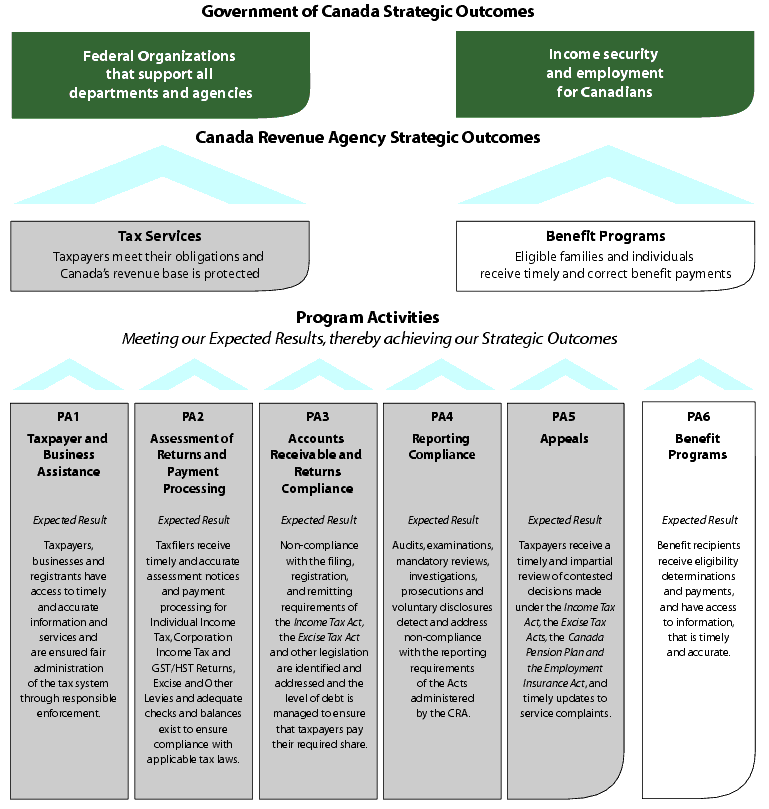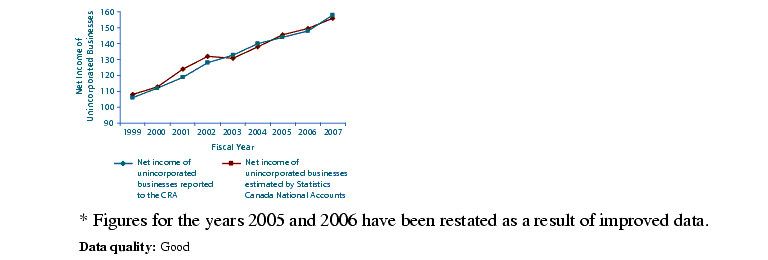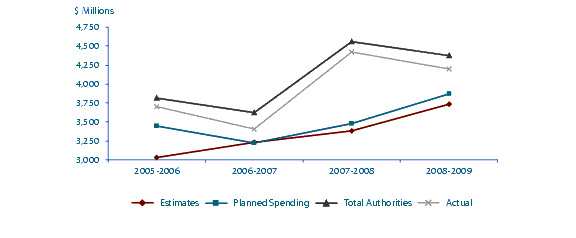Common menu bar links
Breadcrumb Trail
ARCHIVED - Canada Revenue Agency
 This page has been archived.
This page has been archived.
Archived Content
Information identified as archived on the Web is for reference, research or recordkeeping purposes. It has not been altered or updated after the date of archiving. Web pages that are archived on the Web are not subject to the Government of Canada Web Standards. As per the Communications Policy of the Government of Canada, you can request alternate formats on the "Contact Us" page.
Section I: Agency Overview
Message from the Minister

The Canada Revenue Agency (CRA) makes a difference in the lives of Canadians every day. We do this by providing a strong, equitable, and responsive tax system that has become the cornerstone of our country’s prosperity and the foundation of our social structure.
This year, the CRA celebrates 10 years as a government agency, a period marked by innovation and continuous improvement in services to Canadians and businesses.
I am proud of the tremendous collaboration demonstrated by the CRA and Finance Canada, who together worked with financial institutions across the country on the recent launch of the Tax-Free Savings Account (TFSA), the most important tax innovation in a generation.
We are providing excellence in program delivery by working to ensure that Canadians pay their fair share of taxes on behalf of federal, provincial, and territorial governments. In particular, our compliance work includes actions to counter aggressive tax planning, that is, arrangements that cross the boundary of acceptable tax planning.
The CRA is working to encourage Canadian business and the Canadian economy. We are reducing the paperwork burden that impacts business profitability and productivity. This is an important effort, especially in these difficult economic times.
“Together, we are ensuring that Canadians enjoy a flexible and innovative tax regime that is accessible, equitable to taxpayers, and keeps our business solidly competitive in the global marketplace.”
As the administrator of the Scientific Research and Experimental Development (SR&ED) investment tax credit, which is considered one of the best incentives for research and development in the world, the CRA is contributing to Canada’s international business competitiveness. In addition to providing more than $4 billion in tax credits to over 18,000 claimants, we are strengthening our administrative resources to increase SR&ED accessibility to more Canadian businesses.
The steps we are taking to assist individual Canadians and businesses will help maintain the high level of confidence that Canadians have in the CRA. As we move into our second decade as an agency, we will continue to improve our services and respond to the diverse needs of taxpayers and benefit recipients.
It is my privilege and honour to present the Departmental Performance Report 2008-2009 for the Canada Revenue Agency.
The Honourable Jean-Pierre Blackburn, P.C.,
M.P.
Minister of National Revenue and
Minister of State (Agriculture and Agri-Food)
Message from the Commissioner and Chief Executive Officer

As the Commissioner and Chief Executive Officer of the Canada Revenue Agency (CRA), I take pride in being a part of such an outstanding public service organization as it celebrates its tenth anniversary. Looking back, I am inspired by how far we have come and how much we have accomplished during the past decade. We embarked on a program of change to inject fresh ideas into the way we operate and provide service to Canadians. Even though we have been recognized for our innovation and our commitment to service excellence, we know that we cannot simply rely on our past achievements—we can always do better.
Achieving Our Vision
Our vision is to be the model for trusted tax and benefit administration, providing unparalleled service and value to our clients and offering our employees outstanding career opportunities.
“The Canada Revenue Agency is one of the largest service organizations in the country. We do business with more Canadians than any other department or agency of government.”
To achieve our vision, we have pursued two overarching objectives—excellence in program delivery and excellence in the workplace. In terms of excellence in program delivery, we met or exceeded many of our targets. For example, we made it easier for callers to reach us through our telephone service; we worked in close partnership with our provincial counterparts in Alberta, Ontario, and Quebec to recover more than half a billion dollars in taxes from unacceptable aggressive tax planning arrangements that crossed provincial boundaries; we expanded electronic options for business users to include GST/HST NETFILE; and we again achieved very strong results related to the delivery of benefit programs.
In terms of the second overarching objective—excellence in the workplace—we have developed and acted upon the first iteration of our Agency Workforce Plan, which fully integrated human resources and business planning. Several initiatives have been acted upon to address challenges identified in the plan. On March 31, 2009, the second iteration of our Agency Workforce Plan (2009-2010 to 2011-2012) was published, aligned with our Corporate Business Plan, which covered the same period.
Overall, our 2008-2009 results related to the administration of tax and benefit programs remain strong. Most taxpayers met the deadline for filing their returns and for paying amounts owing, and most taxable corporations paid amounts due on time.
We need to ensure, however, that more taxable corporations file their returns on time, and that more employers remit source deductions on behalf of employees on time. Taking all these results into consideration, I remain confident that we can overcome the challenges in key high-risk areas over the long term with a view to achieving our vision.
Progress on Priorities
We have in place an ambitious change agenda to respond to the many challenges we face. During 2008-2009, we made important progress in our commitment to excellence, including the following.
Strengthening service – In December 2008, we launched our comprehensive Service Strategy. This strategy is the result of extensive collaboration with internal stakeholders across the country, with the common objective of working in an integrated and horizontal fashion to develop and deliver our products and services.
Enhancing our efforts to address non-compliance – We conducted our second compliance review this past year. Similar to our first review, this compliance review process resulted in identifying five key high-risk priority areas: aggressive tax planning, the underground economy, payment compliance, wilful non-compliance, and contraband tobacco. As well, we undertook further work to implement our Benefits Compliance Strategy Action Plan by researching and analyzing enforcement and deterrence issues in an effort to understand and evaluate the benefits and credits at risk.
Reinforcing trust – Our service complaints framework has recently made redress more comprehensive. This framework has, at its foundation, the Taxpayer Bill of Rights which has been expanded to include eight service rights. Furthermore, we implemented our Service Complaints Program, to provide taxpayers with a formal resolution process for complaints about mistakes, undue delays, and other issues related to service.
“No longer are we just the federal government’s tax collector—we have become a broad-based tax and benefit administration providing services and support to a wide range of public sector clients.”
Maintaining effective relationships – The strength of our collaborative efforts was demonstrated most recently in the successful conclusion of the Memorandum of Agreement for the harmonization of the Ontario sales tax, the second harmonization initiative that we have undertaken with Ontario. The implementation of corporate tax administration proceeded as planned—on time and within budget.
Meeting our mandate
The overall goal of the CRA is to administer tax, benefits, and related programs and to ensure compliance on behalf of governments across Canada, thereby contributing to the ongoing economic and social well-being of Canadians.
Our employees are known for carrying out their duties with integrity and professionalism. We are an organization that is highly visible—one that touches the lives of all Canadians—and we are very proud of the excellent reputation we’ve earned. The fact that we have once again quickly and accurately delivered on government priorities speaks to the professionalism and dedication of our workforce.
“The CRA is known as a modern and vibrant organization, with a tradition of innovation and technological change.”
Going forward, we will strive to further our working relationships with federal departments, provinces, and territories to forge links between the social responsibility inherent in paying taxes and the civic rights and benefits enjoyed in Canada. We will sustain our strong international presence in organizations such as the Organisation for Economic Co-operation and Development (OECD) and the Inter-American Centre of Tax Administration to advance protocols and practices to guide the work of tax administrations around the world.
We will seek opportunities to reduce the administrative burden and overall cost of government and we will build on our position as an innovative service leader and a separate employer to create a workplace culture of intelligent risk management and innovation.
William V. Baker
Commissioner and Chief Executive Officer
Canada Revenue Agency
Our Raison d’ętre
The Canada Revenue Agency (CRA) has the mandate to administer tax, benefit and other programs on behalf of the Government of Canada and provincial, territorial and First Nations governments.
Parliament created the CRA so we could meet the mandate by:
- providing better service to Canadians;
- offering more efficient and more effective delivery of government programs; and
- fostering closer relationships with provinces and other levels of government for which the CRA delivers programs, and providing better accountability.
The CRA’s mandate reflects the broad role that the Agency plays in the lives of Canadians. The CRA contributes to two of the Government of Canada’s Strategic Outcomes: Federal organizations that support all Government of Canada outcomes and Income Security and Employment for Canadians.
The Canada Revenue Agency (CRA) exercises its mandate within a framework of complex laws enacted by Parliament, as well as by provincial and territorial legislatures. The CRA collected more than $366 billion in 2008-2009 on behalf of Canada, the provinces (except Quebec), territories, and First Nations.
Benefit to Canadians
No other public organization touches the lives of more Canadians on a daily basis than the Canada Revenue Agency (CRA). Each year we administer billions of dollars in tax revenue and distribute timely and accurate benefit payments to millions of Canadians. We deliver income-based benefits, credits, and other services that assist families and children, low and moderate-income households, and persons with disabilities, programs that contribute directly to the economic and social well-being of Canadians.
Our ability to deliver efficient, timely, and accurate high-volume programs and services makes us a valuable partner for government clients.
The following two strategic outcomes summarize the CRA’s contribution to Canadian society.
- Taxpayers meet their obligations and Canada’s revenue base is protected; and
- Eligible families and individuals receive timely and correct benefit payments.
In addition to the administration of income tax and benefit programs, the CRA administers sales tax for three provinces and verifies taxpayer income levels in support of a wide variety of federal, provincial, and territorial programs, ranging from student loans to health care initiatives. We also provide other services, such as the Refund Set-off Program, through which we aid other federal departments, as well as provincial and territorial governments, in the collection of debts that might otherwise become uncollectible.
This Performance Report assesses the extent to which we achieved these outcomes during the 2008-2009 fiscal year. On balance, our results show that we met both our strategic outcomes.
Risk Analysis
The purpose of Enterprise Risk Management (ERM) Program is to ensure that the Agency develops and implements a systematic, comprehensive approach to managing risks as a management function that is fully integrated into the Agency’s decision-making, planning and reporting processes and mechanisms.
In support of corporate risk management, the two key ERM products are the Corporate Risk Inventory (CRI) and the CRA Risk Action Plan. The CRI presents a strategic, high-level snapshot of the Agency’s risk status. The Agency’s response to each risk in the CRI is captured in a companion document, the CRA Risk Action Plan.
In addition to efforts to align corporate risk information with the Agency’s planning and resource allocation cycles, the Agency is making strides to embed risk information and commitments in other key products and processes including the Corporate Business Plan, the Corporate Audit and Evaluation Plan, and the Executive Cadre’s Accountability Regime.
Rating our Results
We use qualitative and quantitative indicators to determine the results achieved in terms of our strategic outcomes and expected results. Survey results, statistical sampling, and operational data inform our assessments. Although we have made progress in developing robust indicators for each of our strategic outcome measures and expected results, we need to make some of them more concrete and measurable.
We also rate our strategic results and those of our program activities in terms of whether the targets identified in our 2008-2009 Report on Plans and Priorities were met, mostly met, or not met.
Our targets identify the percentage or degree we expect to attain for a performance level. Where targets are numeric in nature, they are listed beside each indicator. Performance targets are established by our management teams through analysis of affordability constraints, historical performance, the complexity of the work involved, and the expectations of Canadians.
Our Program Activity Architecture
The Program Activity Architecture depicted below, identifies our program activities (PAs) and demonstrates how they link to our strategic outcomes. This framework is based on the Management, Resources and Results Structure established by the Treasury Board of Canada Secretariat on April 1, 2005.
Program activities are groups of related activities that are designed and managed to meet a specific public need and reflect how we allocate and manage our resources in order to achieve intended results.

Performance Summary
Alignment to Government of Canada Outcomes
|
Main Estimates[Footnote 1]
|
Planned Spending[Footnote 1]
|
Total Authorities[Footnote 2]
|
Actual Spending[Footnote 2]
|
|||
|---|---|---|---|---|---|---|
|
Taxpayer and Business Assistance (PA1)[Footnote 3]
|
||||||
|
Assessment of Returns and Payment Processing (PA2)[Footnote 4]
|
||||||
|
Accounts Receivable and Returns Compliance (PA3)[Footnote 5]
|
||||||
|
Main Estimates[Footnote 1]
|
Planned Spending[Footnote 1]
|
Total Authorities[Footnote 2]
|
Actual Spending[Footnote 2]
|
|||
|---|---|---|---|---|---|---|
|
Benefit Programs (PA6)[Footnote 3]
|
||||||
|
Main Estimates[Footnote 1]
|
Planned Spending[Footnote 1]
|
Total Authorities[Footnote 2]
|
Actual Spending[Footnote 2]
|
||
|---|---|---|---|---|---|
2008-2009 Financial Resources (thousands of dollars)
2008-2009 Human Resources Full Time Equivalents (FTE)
Contribution of Priorities to Strategic Outcomes
As identified in our 2008-2009 Report on Plans and Priorities, our tax and benefit focus over the planning period was on strengthening service, enhancing efforts to address non-compliance, reinforcing trust, and maintaining effective relationships.
The following table identifies the strategic priorities we pursued in 2008-2009, our results, and how these priorities support our Strategic Outcome(s).Additional details concerning individual program activity achievements related to these strategic priorities are provided in Section II: Analysis of Program Activities by Strategic Outcome.
Our Strategic Outcome Measures
We use our strategic outcome measures to gauge the compliance behaviour of Canadian taxpayers. Using data from internal and external sources as a baseline of compliance information, we group these indicators into the following four broad categories of taxpayer obligations to help us measure and assess our results against our Tax Services strategic outcome.
- Registration Compliance estimates the proportion of Canadian businesses that have registered as required by law to collect the GST/HST.
- Filing Compliance indicators estimate the proportion of the Canadian population who file their returns on time.
- Reporting Compliance indicators contribute to our assessment of the degree to which taxpayers report complete and accurate information.
- Remittance Compliance indicators estimate the proportion of taxpayers who owed taxes and paid the full amount on time.
To facilitate further analysis of compliance behaviour, we partition the Canadian taxpayer population into the following types: individuals, self-employed individuals, corporations, GST/HST registrants, and employers. Also included are macro-indicators, which we use to evaluate reporting compliance trends.
Our Tax Services Strategic Outcome Measures
|
Our Indicators[Footnote 1]
|
|||||||
|---|---|---|---|---|---|---|---|
|
Corporations – taxable incorporated businesses that filed their returns
on time[Footnote 2]
|
|||||||
|
Our Indicators[Footnote 1]
|
|||||||
|---|---|---|---|---|---|---|---|
|
Percentage of taxable corporations that paid their reported taxes
on time[Footnote 2]
|
|||||||
|
Businesses that collected
GST/HST[Footnote
3]
|
|||||||
Through the progress we have made during 2008-2009 in implementing major components of our innovation agenda, we believe we have made significant gains towards improving our capacity to protect Canada’s revenue base. Our estimates of taxpayers’ filing, registration, and remittance compliance indicate that overall levels of voluntary compliance with Canada’s tax laws continued to be high in 2008-2009.
Our estimates of reporting compliance, however, indicate the incidence of non-compliance may be slowly increasing. There are indications that the dollars at risk for some taxpayer sectors may be increasing. Although performance results provide evidence that non-compliance is at relatively low levels, the results of our program activities demonstrate that such non-compliance is, in total, financially significant. In 2008-2009, our programs to address reporting non-compliance identified a total dollar value of over $17.8 billion, exceeding our estimates, which we based on historical results combined with available resource levels.
We anticipate the results from the action plans we develop related to our Compliance Review II will have a positive impact on levels of reporting compliance over the long term.
In light of our overall measurement and given that a significant proportion of Canada’s revenue base is subject to third-party reporting, it is our assessment that, for the majority of Canadians, the incidence and magnitude of non-compliance is relatively low, though financially significant. Consequently, it is our assessment that we met our Tax Services strategic outcome in 2008-2009.
Our Benefit Programs Strategic Outcome Measures
It is our assessment that we met our Benefit Programs strategic outcome. Through our efforts in administering benefit programs, eligible families and individuals received timely and correct benefit payments, and our government clients were afforded reliable services, enjoyed lower administration costs and more effective compliance. Benefit recipients can rely on the CRA to administer a better-integrated benefits system of high integrity and be assured that the CRA contributes to reducing the overall cost of government in Canada.
Our Macro Indicators
We also analyze various macro-indicators to evaluate reporting compliance trends. As graphically depicted below, our macro indicators provide us with assurance that taxpayers, in general, are complying with their obligations and that levels of reporting non-compliance are relatively low.
Figure 1: Growth in Personal Income Reported to the CRA Compared With Personal Income Estimated by Statistics Canada

Figure 2: Growth in corporate income taxes that we have assessed tracks favourably with growth in corporate profits before tax estimated by Statistics Canada

Figure 3: Growth in net income of unincorporated businesses reported to us tracks favourably with National Accounts Estimates of the growth in net income of unincorporated Businesses

Figure 4: Due to a variety of factors, including recent reductions in GST rate, trending information related to GST revenue is no longer clear and we can draw no conclusions from this data

Our reporting compliance indicators provide us with a mixed view of taxpayer behaviour. Although our studies of limited populations show material levels of non-compliance, our macro-indicators provide a sense of assurance that levels of reporting non-compliance are relatively low. For these reasons, it is our assessment that, during 2008-2009, we mostly met our reporting compliance expectations.
Expenditure Profile

The trend in the Canada Revenue Agency’s (CRA) reference levels since 2005-2006 is attributable to three main factors, namely, receipt of increased operating resources, contributions to Government-wide expenditure reduction initiatives and fluctuations in the Agency’s statutory authorities. New operating resources were received as a result of collective bargaining settlements and for additional administration activities associated with new initiatives announced in various Federal Budgets and Economic Statements, including the Corporate Tax Administration for Ontario initiative and the Softwood Lumber Products Export Charge Act, 2006. Reference levels have also increased as a result of the transfer from Public Works and Government Services Canada to the CRA to fund accommodation and real property costs. These increases have been offset by the Agency’s contribution to various Government-wide expenditures reduction initiatives. Lastly, fluctuations in the Agency’s statutory authorities related to Children’s Special Allowance payments, employee benefit plan contributions, the spending of revenues received through the conduct of operations pursuant to Section 60 of the Canada Revenue Act, payments to private collection agencies and payments to the provinces under the Softwood Lumber Products Export Charge Act, 2006, have also contributed to the trend in Agency spending over the past four years.
In 2008-2009, of the $4,370.7 million total authority, CRA’s actual spending totalled $4,198.7 million resulting in $172.0 million remaining unexpended at year-end. After deducting unused resources related to the proposed Offshore Trusts initiative and Public Opinion Research savings, the remaining $147.1 million is available for use by the Agency in 2009-2010. This amount represents 3.4% of the total authority.
Voted and Statutory Items
Authorities approved after tabled Main Estimates
The following table details the authorities approved for the Agency after the
Main Estimates and reconciles with the Total Authorities shown on
 .
.
